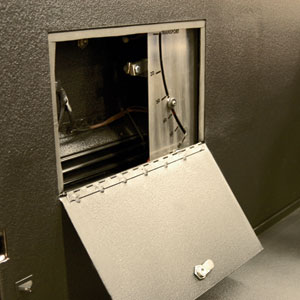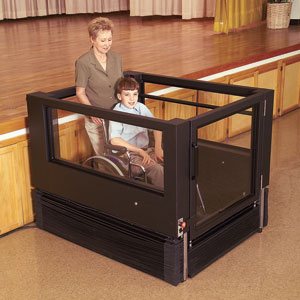Vertical Wheelchair Lifts: Specifying for Safety, Accessibility and Building Needs
User visibility from inside the lift
Once inside the lift, can the user see to the outside?
- Some models with solid sides and doors provide no view to the outside, thus visually entrapping the user during the rising and lowering of the lift.
- Other models are designed with sides and doors fitted with high-impact transparent thermoplastic so the user can see out.
 |
Height adjustment device that sets the upper travel limit of a portable lift Photo: Ascension |
Ease of setting the upper travel limit
The upper travel limit determines the location at which the lift platform will stop for the upper landing. The upper travel limit of a portable lift is adjusted every time the lift is set in place, so setting the limit should be both convenient and safe. One higher-end model uses an adjustment knob behind a locked panel. Facility personnel raise the lift platform to the upper landing, move the knob until it clicks into place, and then tighten the knob to hold the setting.
Platform size
- For a "straight-through" lift with the entrance and exit gates located on opposite ends of the lift car, so that the wheelchair user has a straight approach to the lift from both upper and lower landings, it is commonly accepted practice for the lift car inside platform dimensions to be a minimum of 36 inches x 48 inches. (See ADA Sidebar, page3)
- It should be noted that some scooters and oversized wheelchairs may be too long for a 48 inch long lift car. Choosing a wheelchair lift with a minimum inside car length of 54 inches will allow more users to utilize the lift.
- For wheelchair lifts designed with a "90-degree" or "side opening" configuration (i.e., the entrance and exit gates are located on adjacent sides), it would be reasonable to interpret the minimum platform size as 36 inches x 60 inches since the user would have a straight approach from one landing and a side approach from the other landing. This approach provides additional room for maneuvering.
 |
With transparent sides that are high enough to feel safe, users have a 360-degree view. Photo: Ascension |
Operating controls
- Models in compliance with ADA will meet requirements for controls and operating mechanisms that are operable with one hand, shall not require tight grasping, pinching, or twisting of the wrist and not require force greater than 5 lbf (22.2 N).
Noise of operation
- Can the wheelchair lift be used while an event on stage is in progress? Quiet operation with no rattles and shakes will not interrupt a performance or draw unnecessary attention to passengers. This enhances both the dignity of the passenger and the image of the facility. Lifts with hydraulic systems are typically much quieter and smoother than those with screw drive systems.
Aesthetics
Designers seek a wheelchair lift aesthetic that not only fits the building, but blends into the design of the auditorium or performance center. While some vertical wheelchair lifts have an industrial appearance, other lifts offer a higher level of aesthetic quality through a compact, clean, professional design with few visible moving parts. Again, an appealing appearance generally adds price points.
RELIABILITY AND DURABILITY
The reliability of vertical wheelchair lifts is critical, especially given their public visibility, as is their durability and need for maintenance. Specifiers should, therefore, welcome a quantifiable means for evaluating the reliability and durability of different models. One way is to peruse manufacturers' websites, learn how long a product has been on the market and read testimonials from purchasers who have used machines for at least four or five years. Another method of product evaluation is to compare warranties. Vertical wheelchair lift warranties range from 2 years for the drive train and 1 year for other components for most manufacturers, to 20 years for the drive train and 5 years for parts on higher-end models. Those choosing models with significantly longer warranty periods may safely expect that reliability is directly proportional to the length of the warranty period.









